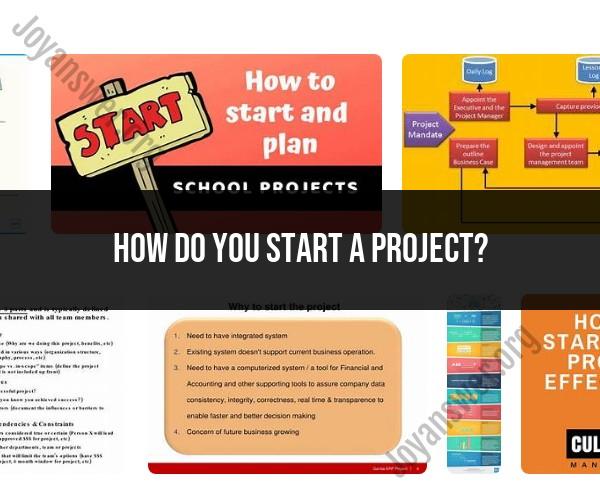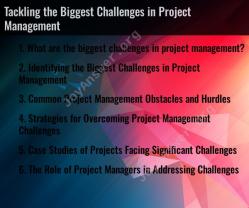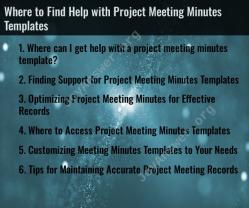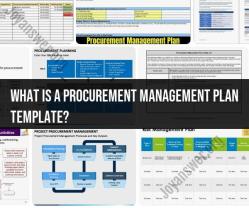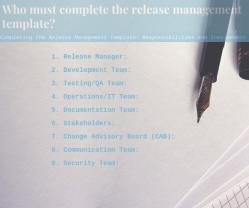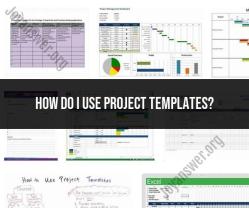How do you start a project?
Starting a project successfully involves careful planning and execution of several key steps. Here is a guide to help you initiate a project effectively:
Define the Project Scope:
- Clearly outline the project's objectives, goals, and deliverables.
- Identify the project's stakeholders and understand their expectations.
- Establish a timeline for the project, including deadlines and milestones.
Assemble a Project Team:
- Identify the team members and their roles and responsibilities.
- Ensure that the team has the necessary skills and resources to complete the project.
- Promote effective communication and collaboration among team members.
Develop a Project Plan:
- Create a detailed project plan that outlines tasks, timelines, dependencies, and resources.
- Allocate budgets and resources based on the project's requirements.
- Identify potential risks and develop a risk management plan.
Set Clear Objectives:
- Define the project's objectives in measurable terms.
- Use the SMART criteria (Specific, Measurable, Achievable, Relevant, Time-bound) to set clear goals.
- Ensure that all stakeholders understand and agree on the project's objectives.
Create a Project Charter:
- Develop a project charter that formally authorizes the project and defines its scope.
- Include key project information, such as objectives, stakeholders, and high-level timelines.
- Obtain approval from relevant stakeholders, including project sponsors.
Establish Communication Protocols:
- Define how project-related information will be communicated among team members and stakeholders.
- Set up regular meetings, reporting structures, and channels of communication.
- Ensure that communication is clear, concise, and timely.
Identify and Manage Risks:
- Identify potential risks and uncertainties that could affect the project's success.
- Develop a risk management plan to mitigate, monitor, and respond to risks.
- Regularly review and update the risk management plan as needed.
Allocate Resources:
- Assign resources, including personnel, equipment, and materials, to project tasks.
- Ensure that resources are available when needed to avoid delays.
- Monitor resource allocation to prevent overallocation or underutilization.
Create a Project Schedule:
- Develop a detailed project schedule that includes task durations and dependencies.
- Use project management tools or software to create and manage the schedule.
- Share the schedule with the team to ensure everyone is aware of their responsibilities and deadlines.
Obtain Stakeholder Buy-In:
- Communicate the project plan and objectives to all stakeholders.
- Address any concerns or questions from stakeholders.
- Obtain formal approval and commitment from project sponsors and key stakeholders.
Launch the Project:
- Hold a project kickoff meeting to officially launch the project.
- Review the project plan, objectives, and expectations with the team.
- Emphasize the importance of meeting deadlines and delivering quality results.
Monitor Progress:
- Regularly track and monitor the progress of the project against the plan.
- Use key performance indicators (KPIs) to measure success and identify areas for improvement.
- Address any deviations from the plan promptly and adjust as necessary.
Document Everything:
- Maintain detailed project documentation, including meeting minutes, progress reports, and change requests.
- Keep a record of all project-related communication and decisions.
- Document lessons learned for future reference.
Celebrate Achievements:
- Recognize and celebrate milestones and achievements along the way.
- Acknowledge the hard work and dedication of the project team.
- Use positive reinforcement to motivate team members.
Review and Adjust:
- Conduct regular project reviews to assess progress and performance.
- Identify areas for improvement and make necessary adjustments to the project plan.
- Continuously learn from the project to enhance future endeavors.
Initiating a project effectively lays the foundation for its success. Clear planning, communication, and stakeholder engagement are key to a smooth project start. Additionally, ongoing monitoring and adaptation are crucial to ensuring that the project stays on track and achieves its objectives.
